Child and Young Person Development: An In-depth Analysis Report
VerifiedAdded on 2020/06/04
|21
|7817
|216
Report
AI Summary
This report provides a comprehensive overview of child and young person development. It begins by explaining the rate and sequence of various developmental aspects, including physical, behavioral, intellectual, communication, moral, emotional, and social development stages from infancy through adolescence. The report then differentiates between the rate and sequence of development and highlights their importance in understanding a child's progress. Furthermore, the report explores the factors influencing young people's development, such as individual factors (genetics, health, learning difficulties) and external factors (environment). The report also discusses methods for monitoring the development of children and young people and examines different types of interventions related to growth and development, providing valuable insights into supporting children's well-being and potential challenges. This report is available on Desklib, a platform for students offering past papers and solved assignments.
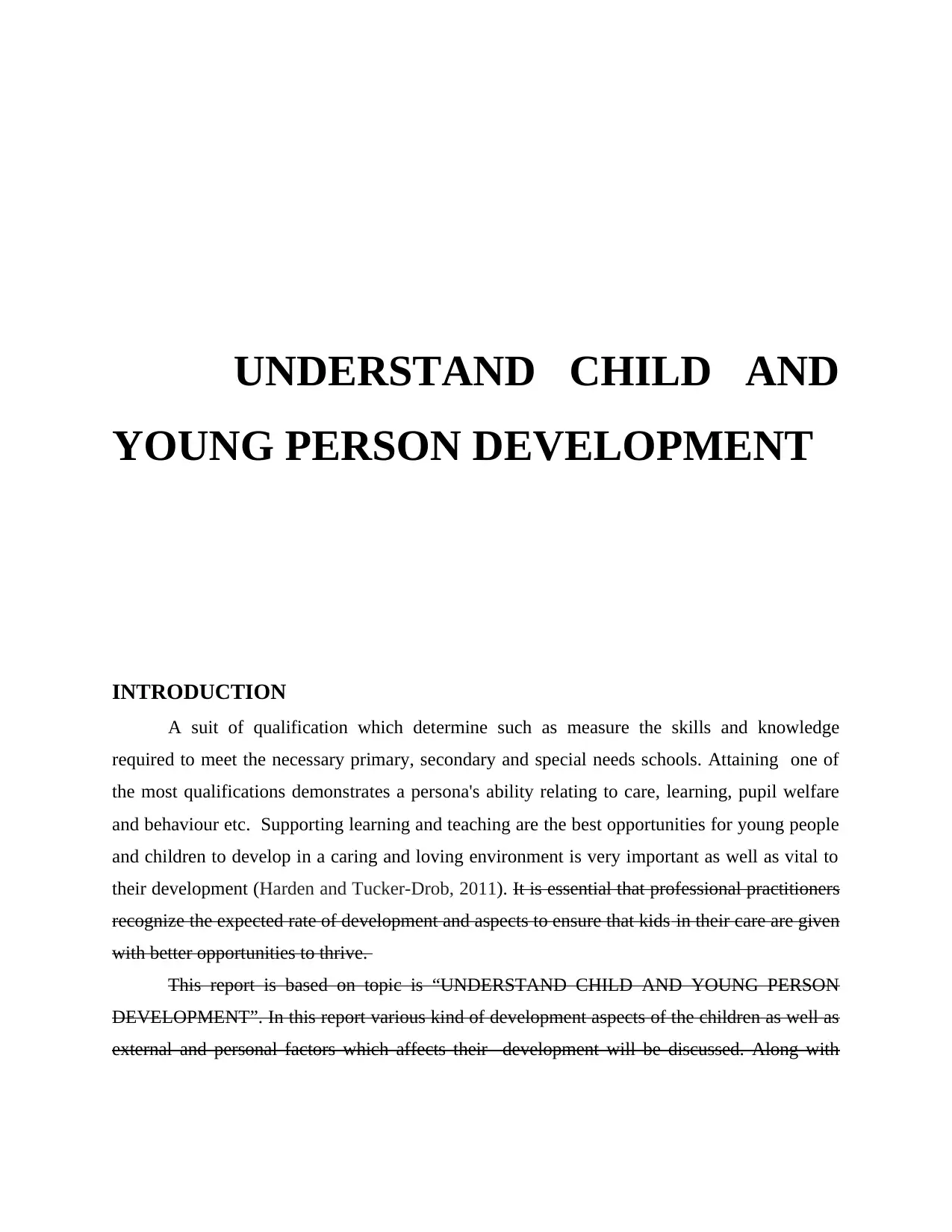
UNDERSTAND CHILD AND
YOUNG PERSON DEVELOPMENT
INTRODUCTION
A suit of qualification which determine such as measure the skills and knowledge
required to meet the necessary primary, secondary and special needs schools. Attaining one of
the most qualifications demonstrates a persona's ability relating to care, learning, pupil welfare
and behaviour etc. Supporting learning and teaching are the best opportunities for young people
and children to develop in a caring and loving environment is very important as well as vital to
their development (Harden and Tucker-Drob, 2011). It is essential that professional practitioners
recognize the expected rate of development and aspects to ensure that kids in their care are given
with better opportunities to thrive.
This report is based on topic is “UNDERSTAND CHILD AND YOUNG PERSON
DEVELOPMENT”. In this report various kind of development aspects of the children as well as
external and personal factors which affects their development will be discussed. Along with
YOUNG PERSON DEVELOPMENT
INTRODUCTION
A suit of qualification which determine such as measure the skills and knowledge
required to meet the necessary primary, secondary and special needs schools. Attaining one of
the most qualifications demonstrates a persona's ability relating to care, learning, pupil welfare
and behaviour etc. Supporting learning and teaching are the best opportunities for young people
and children to develop in a caring and loving environment is very important as well as vital to
their development (Harden and Tucker-Drob, 2011). It is essential that professional practitioners
recognize the expected rate of development and aspects to ensure that kids in their care are given
with better opportunities to thrive.
This report is based on topic is “UNDERSTAND CHILD AND YOUNG PERSON
DEVELOPMENT”. In this report various kind of development aspects of the children as well as
external and personal factors which affects their development will be discussed. Along with
Paraphrase This Document
Need a fresh take? Get an instant paraphrase of this document with our AI Paraphraser
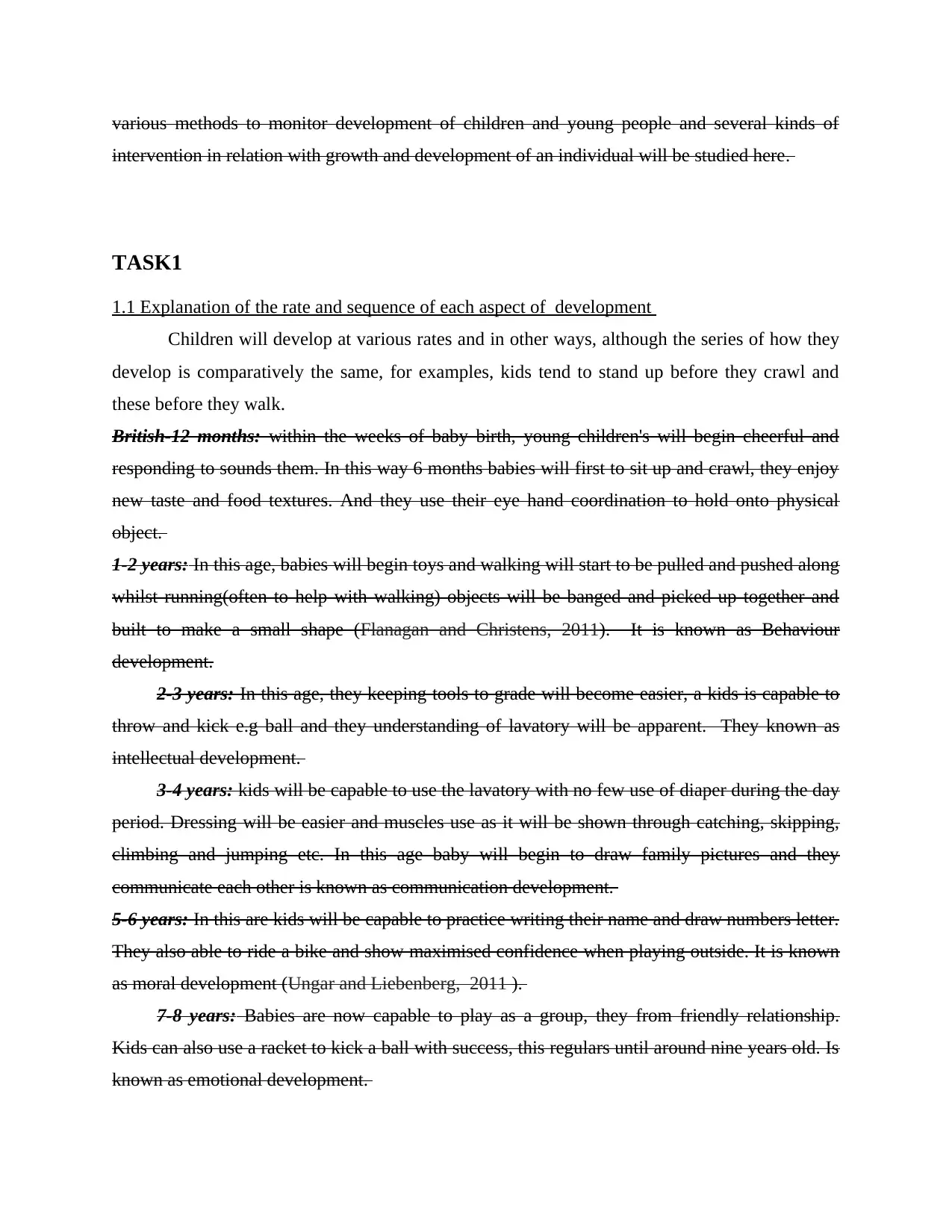
various methods to monitor development of children and young people and several kinds of
intervention in relation with growth and development of an individual will be studied here.
TASK1
1.1 Explanation of the rate and sequence of each aspect of development
Children will develop at various rates and in other ways, although the series of how they
develop is comparatively the same, for examples, kids tend to stand up before they crawl and
these before they walk.
British-12 months: within the weeks of baby birth, young children's will begin cheerful and
responding to sounds them. In this way 6 months babies will first to sit up and crawl, they enjoy
new taste and food textures. And they use their eye hand coordination to hold onto physical
object.
1-2 years: In this age, babies will begin toys and walking will start to be pulled and pushed along
whilst running(often to help with walking) objects will be banged and picked up together and
built to make a small shape (Flanagan and Christens, 2011). It is known as Behaviour
development.
2-3 years: In this age, they keeping tools to grade will become easier, a kids is capable to
throw and kick e.g ball and they understanding of lavatory will be apparent. They known as
intellectual development.
3-4 years: kids will be capable to use the lavatory with no few use of diaper during the day
period. Dressing will be easier and muscles use as it will be shown through catching, skipping,
climbing and jumping etc. In this age baby will begin to draw family pictures and they
communicate each other is known as communication development.
5-6 years: In this are kids will be capable to practice writing their name and draw numbers letter.
They also able to ride a bike and show maximised confidence when playing outside. It is known
as moral development (Ungar and Liebenberg, 2011 ).
7-8 years: Babies are now capable to play as a group, they from friendly relationship.
Kids can also use a racket to kick a ball with success, this regulars until around nine years old. Is
known as emotional development.
intervention in relation with growth and development of an individual will be studied here.
TASK1
1.1 Explanation of the rate and sequence of each aspect of development
Children will develop at various rates and in other ways, although the series of how they
develop is comparatively the same, for examples, kids tend to stand up before they crawl and
these before they walk.
British-12 months: within the weeks of baby birth, young children's will begin cheerful and
responding to sounds them. In this way 6 months babies will first to sit up and crawl, they enjoy
new taste and food textures. And they use their eye hand coordination to hold onto physical
object.
1-2 years: In this age, babies will begin toys and walking will start to be pulled and pushed along
whilst running(often to help with walking) objects will be banged and picked up together and
built to make a small shape (Flanagan and Christens, 2011). It is known as Behaviour
development.
2-3 years: In this age, they keeping tools to grade will become easier, a kids is capable to
throw and kick e.g ball and they understanding of lavatory will be apparent. They known as
intellectual development.
3-4 years: kids will be capable to use the lavatory with no few use of diaper during the day
period. Dressing will be easier and muscles use as it will be shown through catching, skipping,
climbing and jumping etc. In this age baby will begin to draw family pictures and they
communicate each other is known as communication development.
5-6 years: In this are kids will be capable to practice writing their name and draw numbers letter.
They also able to ride a bike and show maximised confidence when playing outside. It is known
as moral development (Ungar and Liebenberg, 2011 ).
7-8 years: Babies are now capable to play as a group, they from friendly relationship.
Kids can also use a racket to kick a ball with success, this regulars until around nine years old. Is
known as emotional development.
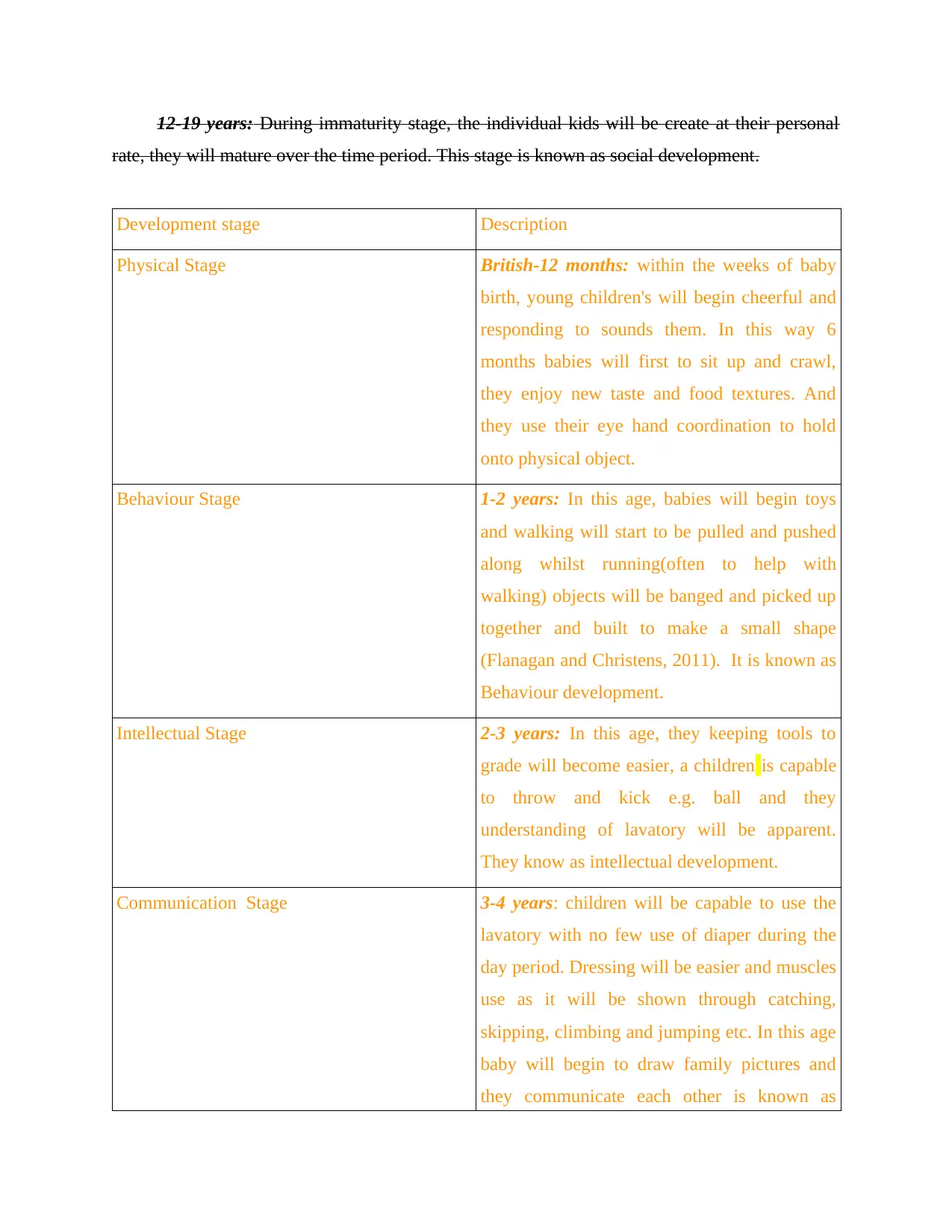
12-19 years: During immaturity stage, the individual kids will be create at their personal
rate, they will mature over the time period. This stage is known as social development.
Development stage Description
Physical Stage British-12 months: within the weeks of baby
birth, young children's will begin cheerful and
responding to sounds them. In this way 6
months babies will first to sit up and crawl,
they enjoy new taste and food textures. And
they use their eye hand coordination to hold
onto physical object.
Behaviour Stage 1-2 years: In this age, babies will begin toys
and walking will start to be pulled and pushed
along whilst running(often to help with
walking) objects will be banged and picked up
together and built to make a small shape
(Flanagan and Christens, 2011). It is known as
Behaviour development.
Intellectual Stage 2-3 years: In this age, they keeping tools to
grade will become easier, a children is capable
to throw and kick e.g. ball and they
understanding of lavatory will be apparent.
They know as intellectual development.
Communication Stage 3-4 years: children will be capable to use the
lavatory with no few use of diaper during the
day period. Dressing will be easier and muscles
use as it will be shown through catching,
skipping, climbing and jumping etc. In this age
baby will begin to draw family pictures and
they communicate each other is known as
rate, they will mature over the time period. This stage is known as social development.
Development stage Description
Physical Stage British-12 months: within the weeks of baby
birth, young children's will begin cheerful and
responding to sounds them. In this way 6
months babies will first to sit up and crawl,
they enjoy new taste and food textures. And
they use their eye hand coordination to hold
onto physical object.
Behaviour Stage 1-2 years: In this age, babies will begin toys
and walking will start to be pulled and pushed
along whilst running(often to help with
walking) objects will be banged and picked up
together and built to make a small shape
(Flanagan and Christens, 2011). It is known as
Behaviour development.
Intellectual Stage 2-3 years: In this age, they keeping tools to
grade will become easier, a children is capable
to throw and kick e.g. ball and they
understanding of lavatory will be apparent.
They know as intellectual development.
Communication Stage 3-4 years: children will be capable to use the
lavatory with no few use of diaper during the
day period. Dressing will be easier and muscles
use as it will be shown through catching,
skipping, climbing and jumping etc. In this age
baby will begin to draw family pictures and
they communicate each other is known as
⊘ This is a preview!⊘
Do you want full access?
Subscribe today to unlock all pages.

Trusted by 1+ million students worldwide
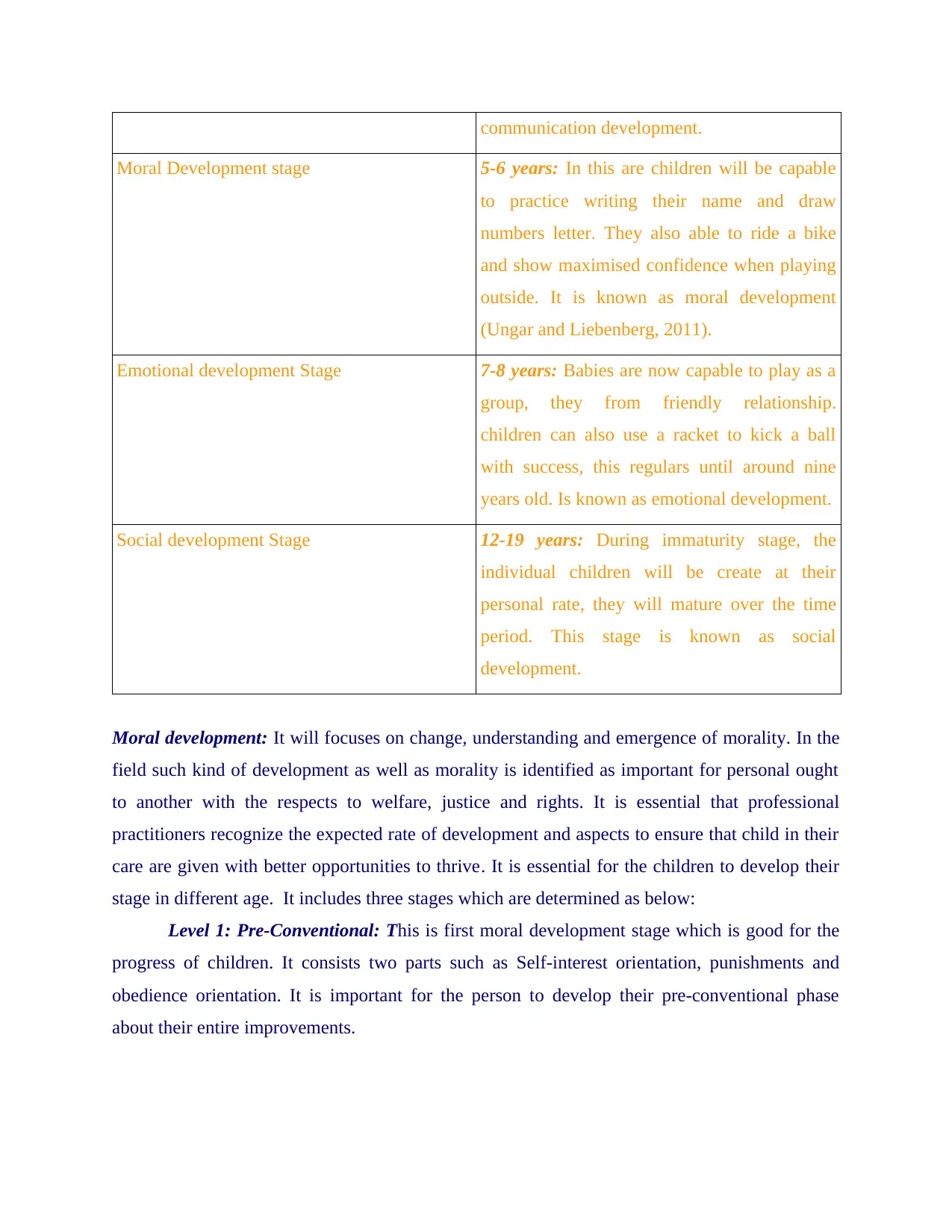
communication development.
Moral Development stage 5-6 years: In this are children will be capable
to practice writing their name and draw
numbers letter. They also able to ride a bike
and show maximised confidence when playing
outside. It is known as moral development
(Ungar and Liebenberg, 2011).
Emotional development Stage 7-8 years: Babies are now capable to play as a
group, they from friendly relationship.
children can also use a racket to kick a ball
with success, this regulars until around nine
years old. Is known as emotional development.
Social development Stage 12-19 years: During immaturity stage, the
individual children will be create at their
personal rate, they will mature over the time
period. This stage is known as social
development.
Moral development: It will focuses on change, understanding and emergence of morality. In the
field such kind of development as well as morality is identified as important for personal ought
to another with the respects to welfare, justice and rights. It is essential that professional
practitioners recognize the expected rate of development and aspects to ensure that child in their
care are given with better opportunities to thrive. It is essential for the children to develop their
stage in different age. It includes three stages which are determined as below:
Level 1: Pre-Conventional: This is first moral development stage which is good for the
progress of children. It consists two parts such as Self-interest orientation, punishments and
obedience orientation. It is important for the person to develop their pre-conventional phase
about their entire improvements.
Moral Development stage 5-6 years: In this are children will be capable
to practice writing their name and draw
numbers letter. They also able to ride a bike
and show maximised confidence when playing
outside. It is known as moral development
(Ungar and Liebenberg, 2011).
Emotional development Stage 7-8 years: Babies are now capable to play as a
group, they from friendly relationship.
children can also use a racket to kick a ball
with success, this regulars until around nine
years old. Is known as emotional development.
Social development Stage 12-19 years: During immaturity stage, the
individual children will be create at their
personal rate, they will mature over the time
period. This stage is known as social
development.
Moral development: It will focuses on change, understanding and emergence of morality. In the
field such kind of development as well as morality is identified as important for personal ought
to another with the respects to welfare, justice and rights. It is essential that professional
practitioners recognize the expected rate of development and aspects to ensure that child in their
care are given with better opportunities to thrive. It is essential for the children to develop their
stage in different age. It includes three stages which are determined as below:
Level 1: Pre-Conventional: This is first moral development stage which is good for the
progress of children. It consists two parts such as Self-interest orientation, punishments and
obedience orientation. It is important for the person to develop their pre-conventional phase
about their entire improvements.
Paraphrase This Document
Need a fresh take? Get an instant paraphrase of this document with our AI Paraphraser

Level 2: Conventional: In this social needs of the children is fulfilled systematically. It
also consists two phase such as interpersonal conformity and accord, social order and authority
maintain orientation. In this stage attitudes of the children and different order morality effected.
Level 3: Post-Conventional: It is identify as a last level which is important for the
development of person in a systematic manner. It includes some aspects such as universal ethical
principles and social contract orientation.
1.2 Difference between rate and sequence development and its important
The development sequence is a formed order of milestones that young people and
children accomplish and meet. Developments in emotional and social, intellectual, physical and
language from continue and birth into adolescence. Its within these fields that a sequence is
settled, for examples a child will learn as well as acquire to hold their brain up before learning to
stand unaided or a kid will learn to run before they can walk. A baby will normally progress
from individual milestones to the future, normally personal accomplishment has a supporting on
the following and if a baby has difficulty group meeting a milestones, it can define delay in
another fields. The development sequence is not to be bemused such as confused with the
development rate as every kid will grow and progress at various speeds.
A baby could execute milestones faster is individual area say language like speaking
than other kind but may take few time to complete a physical process such as walking. The
development rate determine how quick a baby takes to fulfil these milestones as the quick speed
can very form baby to baby, for example individual kid could learn to run at 11 months whereas
other could attain walking at 14 months (O'Keeffe and Clarke-Pearson, 2011). It is essentials to
determine the difference and how every one plays a important role in determining the
accomplishments of a baby, what milepost have been reached and when. They disable charting
of a young person's and child development to give a picture and structure that can measure
where a baby might be in want as well as need of extension or support. Also another factor is
learning difficulties to child's development (Umaña‐Taylor and et. al 2014). In this way children
with learning trouble will required additional help with certain development areas and may
improve a low-self-esteem because they acquire pissed with themselves for not being capable to
do something Like a simple numeracy issue, or read a book
Difference between Sequenced and rate development:
Sequenced Development Rate of development
also consists two phase such as interpersonal conformity and accord, social order and authority
maintain orientation. In this stage attitudes of the children and different order morality effected.
Level 3: Post-Conventional: It is identify as a last level which is important for the
development of person in a systematic manner. It includes some aspects such as universal ethical
principles and social contract orientation.
1.2 Difference between rate and sequence development and its important
The development sequence is a formed order of milestones that young people and
children accomplish and meet. Developments in emotional and social, intellectual, physical and
language from continue and birth into adolescence. Its within these fields that a sequence is
settled, for examples a child will learn as well as acquire to hold their brain up before learning to
stand unaided or a kid will learn to run before they can walk. A baby will normally progress
from individual milestones to the future, normally personal accomplishment has a supporting on
the following and if a baby has difficulty group meeting a milestones, it can define delay in
another fields. The development sequence is not to be bemused such as confused with the
development rate as every kid will grow and progress at various speeds.
A baby could execute milestones faster is individual area say language like speaking
than other kind but may take few time to complete a physical process such as walking. The
development rate determine how quick a baby takes to fulfil these milestones as the quick speed
can very form baby to baby, for example individual kid could learn to run at 11 months whereas
other could attain walking at 14 months (O'Keeffe and Clarke-Pearson, 2011). It is essentials to
determine the difference and how every one plays a important role in determining the
accomplishments of a baby, what milepost have been reached and when. They disable charting
of a young person's and child development to give a picture and structure that can measure
where a baby might be in want as well as need of extension or support. Also another factor is
learning difficulties to child's development (Umaña‐Taylor and et. al 2014). In this way children
with learning trouble will required additional help with certain development areas and may
improve a low-self-esteem because they acquire pissed with themselves for not being capable to
do something Like a simple numeracy issue, or read a book
Difference between Sequenced and rate development:
Sequenced Development Rate of development
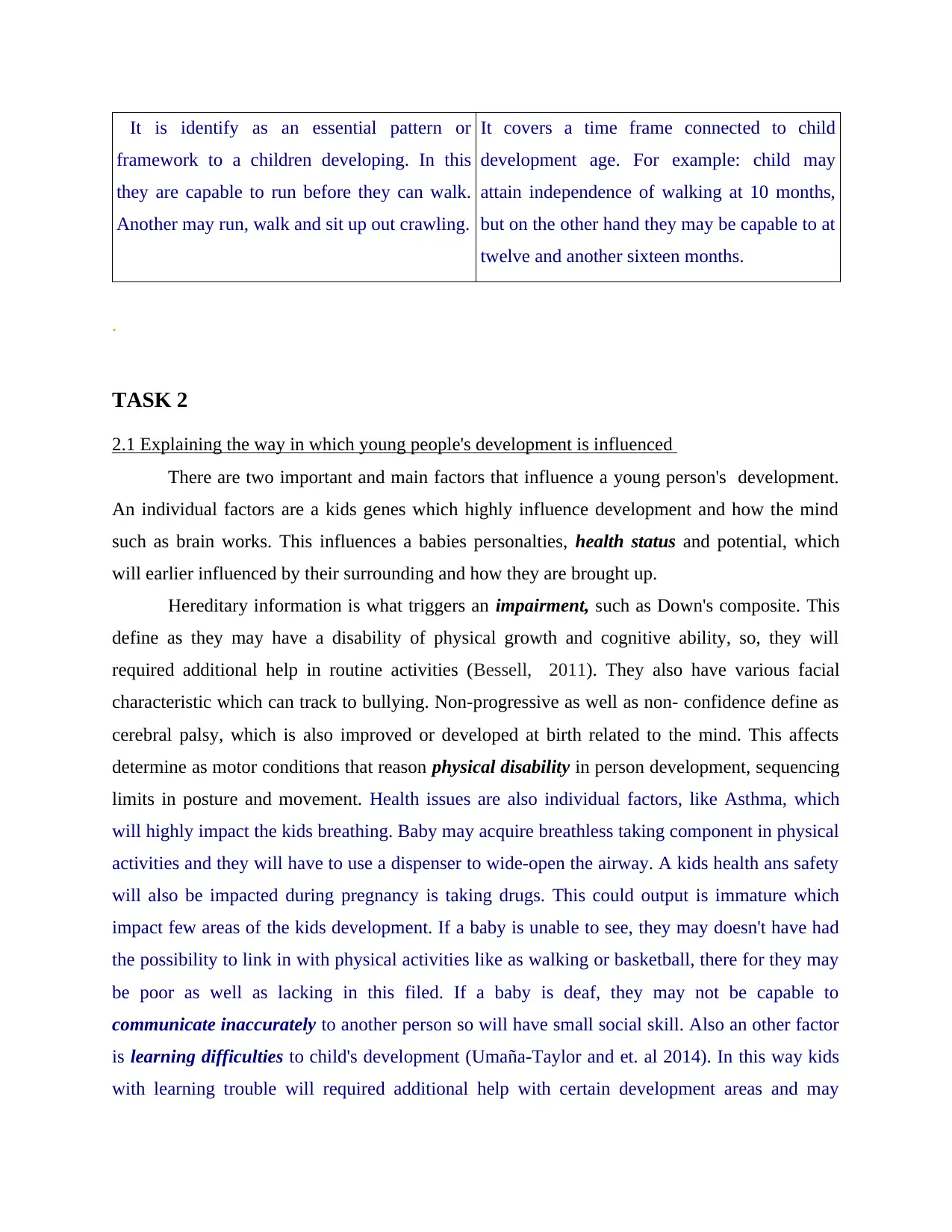
It is identify as an essential pattern or
framework to a children developing. In this
they are capable to run before they can walk.
Another may run, walk and sit up out crawling.
It covers a time frame connected to child
development age. For example: child may
attain independence of walking at 10 months,
but on the other hand they may be capable to at
twelve and another sixteen months.
.
TASK 2
2.1 Explaining the way in which young people's development is influenced
There are two important and main factors that influence a young person's development.
An individual factors are a kids genes which highly influence development and how the mind
such as brain works. This influences a babies personalties, health status and potential, which
will earlier influenced by their surrounding and how they are brought up.
Hereditary information is what triggers an impairment, such as Down's composite. This
define as they may have a disability of physical growth and cognitive ability, so, they will
required additional help in routine activities (Bessell, 2011). They also have various facial
characteristic which can track to bullying. Non-progressive as well as non- confidence define as
cerebral palsy, which is also improved or developed at birth related to the mind. This affects
determine as motor conditions that reason physical disability in person development, sequencing
limits in posture and movement. Health issues are also individual factors, like Asthma, which
will highly impact the kids breathing. Baby may acquire breathless taking component in physical
activities and they will have to use a dispenser to wide-open the airway. A kids health ans safety
will also be impacted during pregnancy is taking drugs. This could output is immature which
impact few areas of the kids development. If a baby is unable to see, they may doesn't have had
the possibility to link in with physical activities like as walking or basketball, there for they may
be poor as well as lacking in this filed. If a baby is deaf, they may not be capable to
communicate inaccurately to another person so will have small social skill. Also an other factor
is learning difficulties to child's development (Umaña‐Taylor and et. al 2014). In this way kids
with learning trouble will required additional help with certain development areas and may
framework to a children developing. In this
they are capable to run before they can walk.
Another may run, walk and sit up out crawling.
It covers a time frame connected to child
development age. For example: child may
attain independence of walking at 10 months,
but on the other hand they may be capable to at
twelve and another sixteen months.
.
TASK 2
2.1 Explaining the way in which young people's development is influenced
There are two important and main factors that influence a young person's development.
An individual factors are a kids genes which highly influence development and how the mind
such as brain works. This influences a babies personalties, health status and potential, which
will earlier influenced by their surrounding and how they are brought up.
Hereditary information is what triggers an impairment, such as Down's composite. This
define as they may have a disability of physical growth and cognitive ability, so, they will
required additional help in routine activities (Bessell, 2011). They also have various facial
characteristic which can track to bullying. Non-progressive as well as non- confidence define as
cerebral palsy, which is also improved or developed at birth related to the mind. This affects
determine as motor conditions that reason physical disability in person development, sequencing
limits in posture and movement. Health issues are also individual factors, like Asthma, which
will highly impact the kids breathing. Baby may acquire breathless taking component in physical
activities and they will have to use a dispenser to wide-open the airway. A kids health ans safety
will also be impacted during pregnancy is taking drugs. This could output is immature which
impact few areas of the kids development. If a baby is unable to see, they may doesn't have had
the possibility to link in with physical activities like as walking or basketball, there for they may
be poor as well as lacking in this filed. If a baby is deaf, they may not be capable to
communicate inaccurately to another person so will have small social skill. Also an other factor
is learning difficulties to child's development (Umaña‐Taylor and et. al 2014). In this way kids
with learning trouble will required additional help with certain development areas and may
⊘ This is a preview!⊘
Do you want full access?
Subscribe today to unlock all pages.

Trusted by 1+ million students worldwide
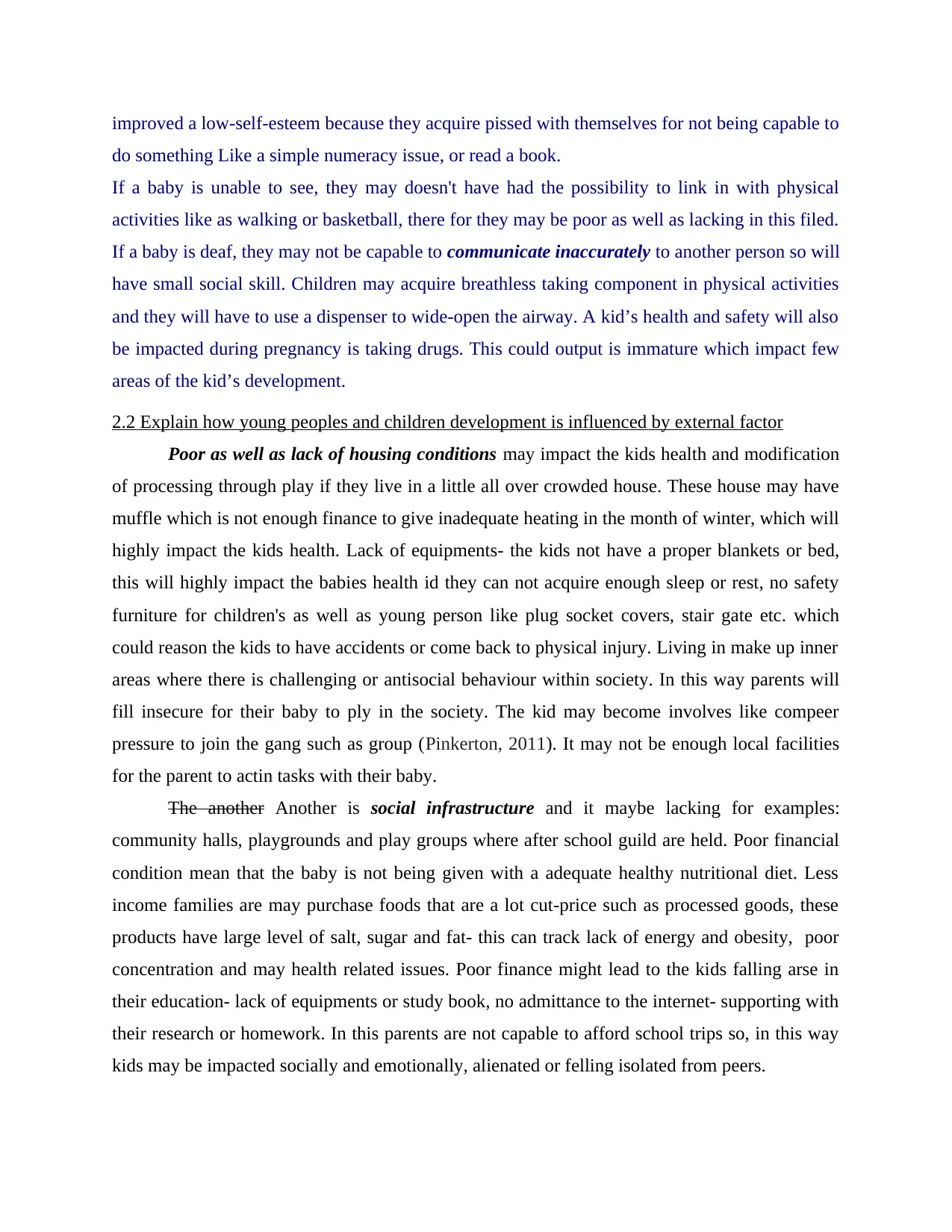
improved a low-self-esteem because they acquire pissed with themselves for not being capable to
do something Like a simple numeracy issue, or read a book.
If a baby is unable to see, they may doesn't have had the possibility to link in with physical
activities like as walking or basketball, there for they may be poor as well as lacking in this filed.
If a baby is deaf, they may not be capable to communicate inaccurately to another person so will
have small social skill. Children may acquire breathless taking component in physical activities
and they will have to use a dispenser to wide-open the airway. A kid’s health and safety will also
be impacted during pregnancy is taking drugs. This could output is immature which impact few
areas of the kid’s development.
2.2 Explain how young peoples and children development is influenced by external factor
Poor as well as lack of housing conditions may impact the kids health and modification
of processing through play if they live in a little all over crowded house. These house may have
muffle which is not enough finance to give inadequate heating in the month of winter, which will
highly impact the kids health. Lack of equipments- the kids not have a proper blankets or bed,
this will highly impact the babies health id they can not acquire enough sleep or rest, no safety
furniture for children's as well as young person like plug socket covers, stair gate etc. which
could reason the kids to have accidents or come back to physical injury. Living in make up inner
areas where there is challenging or antisocial behaviour within society. In this way parents will
fill insecure for their baby to ply in the society. The kid may become involves like compeer
pressure to join the gang such as group (Pinkerton, 2011). It may not be enough local facilities
for the parent to actin tasks with their baby.
The another Another is social infrastructure and it maybe lacking for examples:
community halls, playgrounds and play groups where after school guild are held. Poor financial
condition mean that the baby is not being given with a adequate healthy nutritional diet. Less
income families are may purchase foods that are a lot cut-price such as processed goods, these
products have large level of salt, sugar and fat- this can track lack of energy and obesity, poor
concentration and may health related issues. Poor finance might lead to the kids falling arse in
their education- lack of equipments or study book, no admittance to the internet- supporting with
their research or homework. In this parents are not capable to afford school trips so, in this way
kids may be impacted socially and emotionally, alienated or felling isolated from peers.
do something Like a simple numeracy issue, or read a book.
If a baby is unable to see, they may doesn't have had the possibility to link in with physical
activities like as walking or basketball, there for they may be poor as well as lacking in this filed.
If a baby is deaf, they may not be capable to communicate inaccurately to another person so will
have small social skill. Children may acquire breathless taking component in physical activities
and they will have to use a dispenser to wide-open the airway. A kid’s health and safety will also
be impacted during pregnancy is taking drugs. This could output is immature which impact few
areas of the kid’s development.
2.2 Explain how young peoples and children development is influenced by external factor
Poor as well as lack of housing conditions may impact the kids health and modification
of processing through play if they live in a little all over crowded house. These house may have
muffle which is not enough finance to give inadequate heating in the month of winter, which will
highly impact the kids health. Lack of equipments- the kids not have a proper blankets or bed,
this will highly impact the babies health id they can not acquire enough sleep or rest, no safety
furniture for children's as well as young person like plug socket covers, stair gate etc. which
could reason the kids to have accidents or come back to physical injury. Living in make up inner
areas where there is challenging or antisocial behaviour within society. In this way parents will
fill insecure for their baby to ply in the society. The kid may become involves like compeer
pressure to join the gang such as group (Pinkerton, 2011). It may not be enough local facilities
for the parent to actin tasks with their baby.
The another Another is social infrastructure and it maybe lacking for examples:
community halls, playgrounds and play groups where after school guild are held. Poor financial
condition mean that the baby is not being given with a adequate healthy nutritional diet. Less
income families are may purchase foods that are a lot cut-price such as processed goods, these
products have large level of salt, sugar and fat- this can track lack of energy and obesity, poor
concentration and may health related issues. Poor finance might lead to the kids falling arse in
their education- lack of equipments or study book, no admittance to the internet- supporting with
their research or homework. In this parents are not capable to afford school trips so, in this way
kids may be impacted socially and emotionally, alienated or felling isolated from peers.
Paraphrase This Document
Need a fresh take? Get an instant paraphrase of this document with our AI Paraphraser
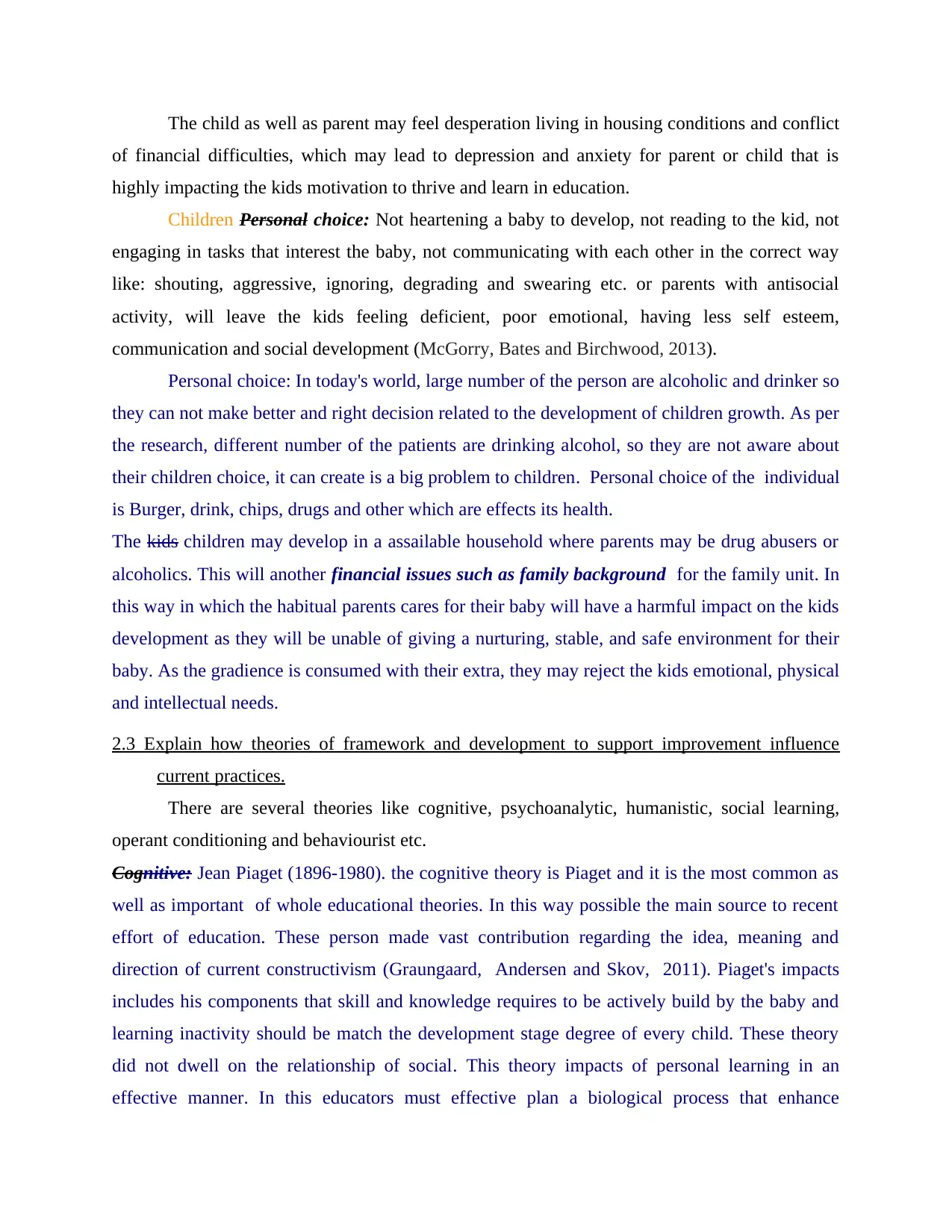
The child as well as parent may feel desperation living in housing conditions and conflict
of financial difficulties, which may lead to depression and anxiety for parent or child that is
highly impacting the kids motivation to thrive and learn in education.
Children Personal choice: Not heartening a baby to develop, not reading to the kid, not
engaging in tasks that interest the baby, not communicating with each other in the correct way
like: shouting, aggressive, ignoring, degrading and swearing etc. or parents with antisocial
activity, will leave the kids feeling deficient, poor emotional, having less self esteem,
communication and social development (McGorry, Bates and Birchwood, 2013).
Personal choice: In today's world, large number of the person are alcoholic and drinker so
they can not make better and right decision related to the development of children growth. As per
the research, different number of the patients are drinking alcohol, so they are not aware about
their children choice, it can create is a big problem to children. Personal choice of the individual
is Burger, drink, chips, drugs and other which are effects its health.
The kids children may develop in a assailable household where parents may be drug abusers or
alcoholics. This will another financial issues such as family background for the family unit. In
this way in which the habitual parents cares for their baby will have a harmful impact on the kids
development as they will be unable of giving a nurturing, stable, and safe environment for their
baby. As the gradience is consumed with their extra, they may reject the kids emotional, physical
and intellectual needs.
2.3 Explain how theories of framework and development to support improvement influence
current practices.
There are several theories like cognitive, psychoanalytic, humanistic, social learning,
operant conditioning and behaviourist etc.
Cognitive: Jean Piaget (1896-1980). the cognitive theory is Piaget and it is the most common as
well as important of whole educational theories. In this way possible the main source to recent
effort of education. These person made vast contribution regarding the idea, meaning and
direction of current constructivism (Graungaard, Andersen and Skov, 2011). Piaget's impacts
includes his components that skill and knowledge requires to be actively build by the baby and
learning inactivity should be match the development stage degree of every child. These theory
did not dwell on the relationship of social. This theory impacts of personal learning in an
effective manner. In this educators must effective plan a biological process that enhance
of financial difficulties, which may lead to depression and anxiety for parent or child that is
highly impacting the kids motivation to thrive and learn in education.
Children Personal choice: Not heartening a baby to develop, not reading to the kid, not
engaging in tasks that interest the baby, not communicating with each other in the correct way
like: shouting, aggressive, ignoring, degrading and swearing etc. or parents with antisocial
activity, will leave the kids feeling deficient, poor emotional, having less self esteem,
communication and social development (McGorry, Bates and Birchwood, 2013).
Personal choice: In today's world, large number of the person are alcoholic and drinker so
they can not make better and right decision related to the development of children growth. As per
the research, different number of the patients are drinking alcohol, so they are not aware about
their children choice, it can create is a big problem to children. Personal choice of the individual
is Burger, drink, chips, drugs and other which are effects its health.
The kids children may develop in a assailable household where parents may be drug abusers or
alcoholics. This will another financial issues such as family background for the family unit. In
this way in which the habitual parents cares for their baby will have a harmful impact on the kids
development as they will be unable of giving a nurturing, stable, and safe environment for their
baby. As the gradience is consumed with their extra, they may reject the kids emotional, physical
and intellectual needs.
2.3 Explain how theories of framework and development to support improvement influence
current practices.
There are several theories like cognitive, psychoanalytic, humanistic, social learning,
operant conditioning and behaviourist etc.
Cognitive: Jean Piaget (1896-1980). the cognitive theory is Piaget and it is the most common as
well as important of whole educational theories. In this way possible the main source to recent
effort of education. These person made vast contribution regarding the idea, meaning and
direction of current constructivism (Graungaard, Andersen and Skov, 2011). Piaget's impacts
includes his components that skill and knowledge requires to be actively build by the baby and
learning inactivity should be match the development stage degree of every child. These theory
did not dwell on the relationship of social. This theory impacts of personal learning in an
effective manner. In this educators must effective plan a biological process that enhance
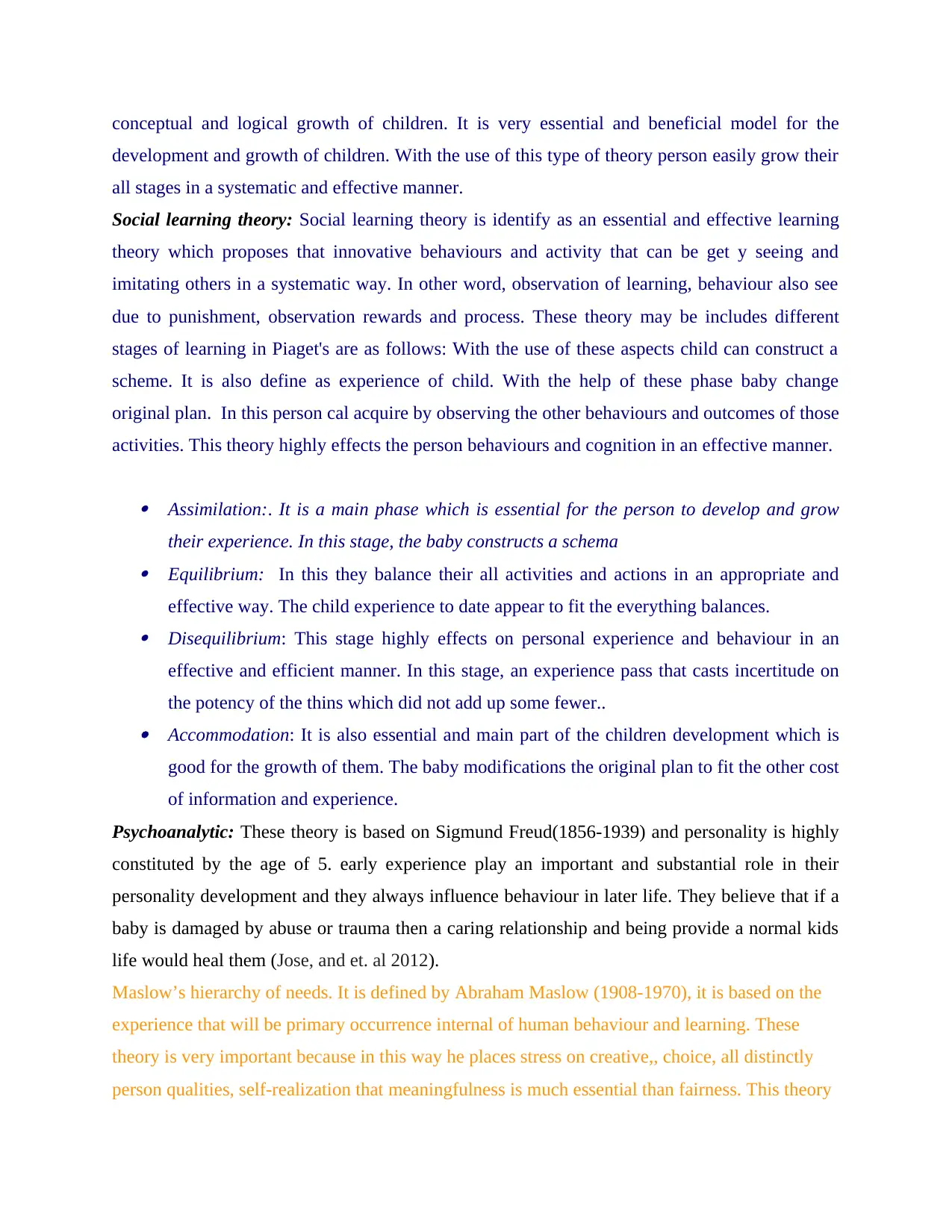
conceptual and logical growth of children. It is very essential and beneficial model for the
development and growth of children. With the use of this type of theory person easily grow their
all stages in a systematic and effective manner.
Social learning theory: Social learning theory is identify as an essential and effective learning
theory which proposes that innovative behaviours and activity that can be get y seeing and
imitating others in a systematic way. In other word, observation of learning, behaviour also see
due to punishment, observation rewards and process. These theory may be includes different
stages of learning in Piaget's are as follows: With the use of these aspects child can construct a
scheme. It is also define as experience of child. With the help of these phase baby change
original plan. In this person cal acquire by observing the other behaviours and outcomes of those
activities. This theory highly effects the person behaviours and cognition in an effective manner.
Assimilation:. It is a main phase which is essential for the person to develop and grow
their experience. In this stage, the baby constructs a schema Equilibrium: In this they balance their all activities and actions in an appropriate and
effective way. The child experience to date appear to fit the everything balances. Disequilibrium: This stage highly effects on personal experience and behaviour in an
effective and efficient manner. In this stage, an experience pass that casts incertitude on
the potency of the thins which did not add up some fewer.. Accommodation: It is also essential and main part of the children development which is
good for the growth of them. The baby modifications the original plan to fit the other cost
of information and experience.
Psychoanalytic: These theory is based on Sigmund Freud(1856-1939) and personality is highly
constituted by the age of 5. early experience play an important and substantial role in their
personality development and they always influence behaviour in later life. They believe that if a
baby is damaged by abuse or trauma then a caring relationship and being provide a normal kids
life would heal them (Jose, and et. al 2012).
Maslow’s hierarchy of needs. It is defined by Abraham Maslow (1908-1970), it is based on the
experience that will be primary occurrence internal of human behaviour and learning. These
theory is very important because in this way he places stress on creative,, choice, all distinctly
person qualities, self-realization that meaningfulness is much essential than fairness. This theory
development and growth of children. With the use of this type of theory person easily grow their
all stages in a systematic and effective manner.
Social learning theory: Social learning theory is identify as an essential and effective learning
theory which proposes that innovative behaviours and activity that can be get y seeing and
imitating others in a systematic way. In other word, observation of learning, behaviour also see
due to punishment, observation rewards and process. These theory may be includes different
stages of learning in Piaget's are as follows: With the use of these aspects child can construct a
scheme. It is also define as experience of child. With the help of these phase baby change
original plan. In this person cal acquire by observing the other behaviours and outcomes of those
activities. This theory highly effects the person behaviours and cognition in an effective manner.
Assimilation:. It is a main phase which is essential for the person to develop and grow
their experience. In this stage, the baby constructs a schema Equilibrium: In this they balance their all activities and actions in an appropriate and
effective way. The child experience to date appear to fit the everything balances. Disequilibrium: This stage highly effects on personal experience and behaviour in an
effective and efficient manner. In this stage, an experience pass that casts incertitude on
the potency of the thins which did not add up some fewer.. Accommodation: It is also essential and main part of the children development which is
good for the growth of them. The baby modifications the original plan to fit the other cost
of information and experience.
Psychoanalytic: These theory is based on Sigmund Freud(1856-1939) and personality is highly
constituted by the age of 5. early experience play an important and substantial role in their
personality development and they always influence behaviour in later life. They believe that if a
baby is damaged by abuse or trauma then a caring relationship and being provide a normal kids
life would heal them (Jose, and et. al 2012).
Maslow’s hierarchy of needs. It is defined by Abraham Maslow (1908-1970), it is based on the
experience that will be primary occurrence internal of human behaviour and learning. These
theory is very important because in this way he places stress on creative,, choice, all distinctly
person qualities, self-realization that meaningfulness is much essential than fairness. This theory
⊘ This is a preview!⊘
Do you want full access?
Subscribe today to unlock all pages.

Trusted by 1+ million students worldwide
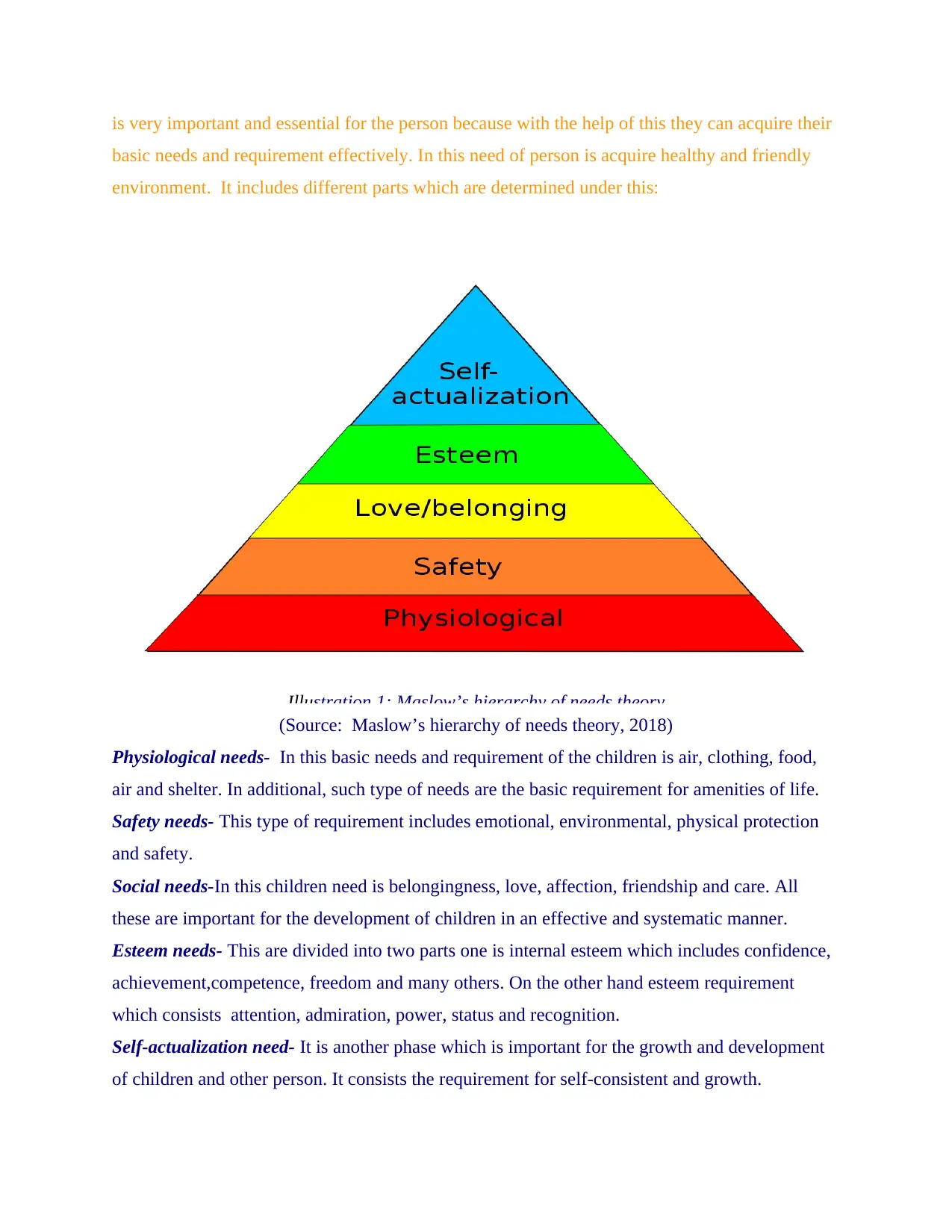
is very important and essential for the person because with the help of this they can acquire their
basic needs and requirement effectively. In this need of person is acquire healthy and friendly
environment. It includes different parts which are determined under this:
(Source: Maslow’s hierarchy of needs theory, 2018)
Physiological needs- In this basic needs and requirement of the children is air, clothing, food,
air and shelter. In additional, such type of needs are the basic requirement for amenities of life.
Safety needs- This type of requirement includes emotional, environmental, physical protection
and safety.
Social needs-In this children need is belongingness, love, affection, friendship and care. All
these are important for the development of children in an effective and systematic manner.
Esteem needs- This are divided into two parts one is internal esteem which includes confidence,
achievement,competence, freedom and many others. On the other hand esteem requirement
which consists attention, admiration, power, status and recognition.
Self-actualization need- It is another phase which is important for the growth and development
of children and other person. It consists the requirement for self-consistent and growth.
Illustration 1: Maslow’s hierarchy of needs theory
basic needs and requirement effectively. In this need of person is acquire healthy and friendly
environment. It includes different parts which are determined under this:
(Source: Maslow’s hierarchy of needs theory, 2018)
Physiological needs- In this basic needs and requirement of the children is air, clothing, food,
air and shelter. In additional, such type of needs are the basic requirement for amenities of life.
Safety needs- This type of requirement includes emotional, environmental, physical protection
and safety.
Social needs-In this children need is belongingness, love, affection, friendship and care. All
these are important for the development of children in an effective and systematic manner.
Esteem needs- This are divided into two parts one is internal esteem which includes confidence,
achievement,competence, freedom and many others. On the other hand esteem requirement
which consists attention, admiration, power, status and recognition.
Self-actualization need- It is another phase which is important for the growth and development
of children and other person. It consists the requirement for self-consistent and growth.
Illustration 1: Maslow’s hierarchy of needs theory
Paraphrase This Document
Need a fresh take? Get an instant paraphrase of this document with our AI Paraphraser

Humanist: Abraham Maslow (1908-1970), it is based on the experience that will be primary
occurrence internal of human behaviour and learning. These theory is very important because in
this way he places stress on creative,, choice, all distinctly person qualities, self-realization that
meaningfulness is much essential than fairness.
Operant conditioning: B.F Skinner(1905-1990). They believes that it is not helpful to use these
theory regarding mental states that could not be ascertained. He believes the child behaviour
which is depends on its effects and if they have even punishments and reinforcements, which
make it around likely that this activity will take other place again.
Behaviourist: John B Watson(1878-1958) these person was generated the term of
“Behaviourism” in 1913. He used adjacency to spell out learning. He was also considers the
emotion to acquire other examples like standard training (Yoshikawa and Kalil, 2011).
“Social pedagogy seeks to take together concepts and theories from sociology, education and
physiology to generate a holistic working way with young people and children.”
Social pedagogy: Social pedagogy seeks to take together concepts and theories from sociology,
education and physiology to generate a holistic working way with young people and children. It
is describe as a relationship created and holistic way of functioning in education and care setting
with person across the resourceful.
TASK 3
3.1 How to control children and young people's development
There are different methods like assessment framework, observation, standard
measurement and information from carers and colleagues etc. but we use only two methods
which are as follows:
Child observations: Observation is done to find out regarding children's needs, what they are
involved in and what they can do. Under this way we can take different note on kids responses
in various situations. Then we can determine our highlight and observations babies achievements
or their required for further help. In this way we also observe kids so in this way we can see the
children's progress are making. As observation is very important and it support us to decide
where kids are in their development and learning as well as to plan what to do. This is an
occurrence internal of human behaviour and learning. These theory is very important because in
this way he places stress on creative,, choice, all distinctly person qualities, self-realization that
meaningfulness is much essential than fairness.
Operant conditioning: B.F Skinner(1905-1990). They believes that it is not helpful to use these
theory regarding mental states that could not be ascertained. He believes the child behaviour
which is depends on its effects and if they have even punishments and reinforcements, which
make it around likely that this activity will take other place again.
Behaviourist: John B Watson(1878-1958) these person was generated the term of
“Behaviourism” in 1913. He used adjacency to spell out learning. He was also considers the
emotion to acquire other examples like standard training (Yoshikawa and Kalil, 2011).
“Social pedagogy seeks to take together concepts and theories from sociology, education and
physiology to generate a holistic working way with young people and children.”
Social pedagogy: Social pedagogy seeks to take together concepts and theories from sociology,
education and physiology to generate a holistic working way with young people and children. It
is describe as a relationship created and holistic way of functioning in education and care setting
with person across the resourceful.
TASK 3
3.1 How to control children and young people's development
There are different methods like assessment framework, observation, standard
measurement and information from carers and colleagues etc. but we use only two methods
which are as follows:
Child observations: Observation is done to find out regarding children's needs, what they are
involved in and what they can do. Under this way we can take different note on kids responses
in various situations. Then we can determine our highlight and observations babies achievements
or their required for further help. In this way we also observe kids so in this way we can see the
children's progress are making. As observation is very important and it support us to decide
where kids are in their development and learning as well as to plan what to do. This is an
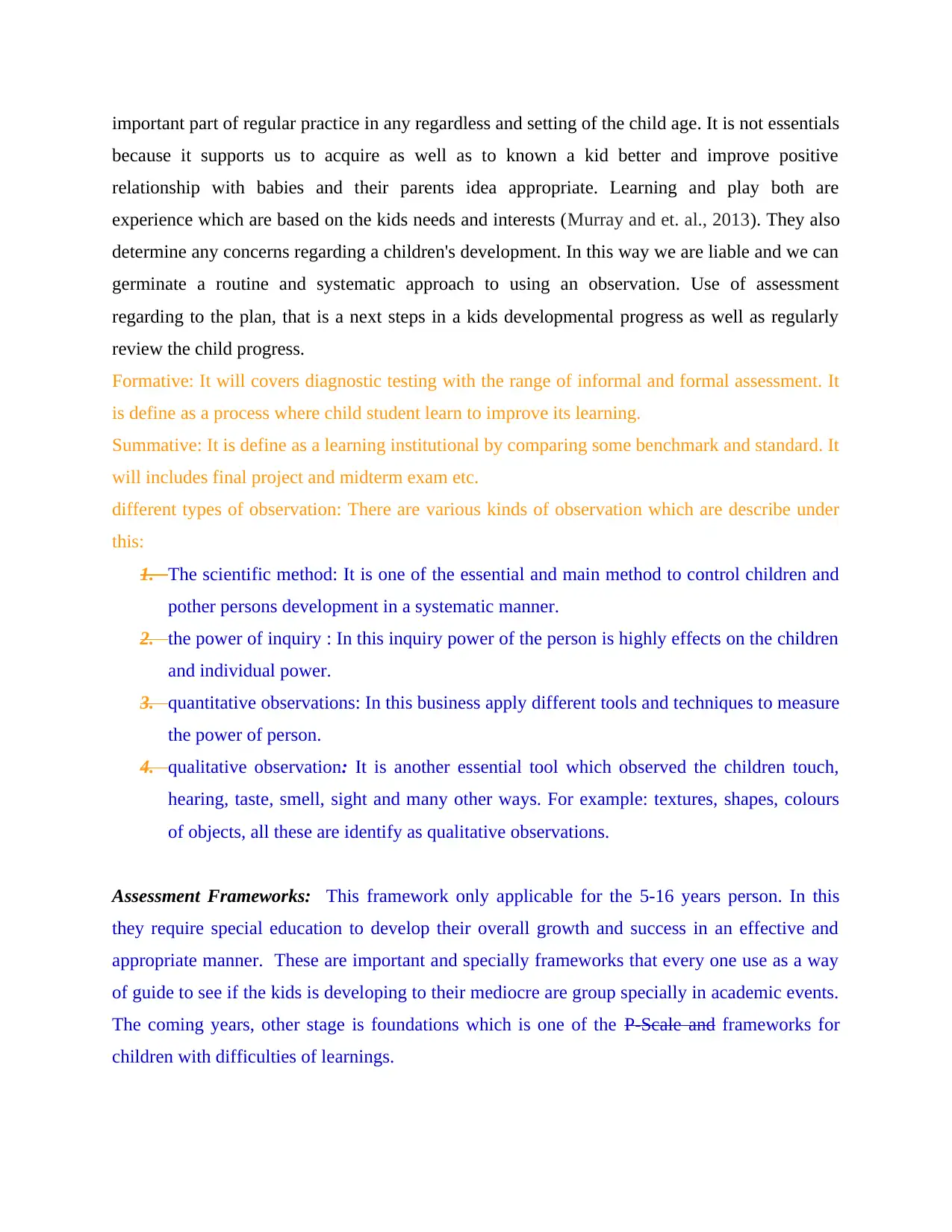
important part of regular practice in any regardless and setting of the child age. It is not essentials
because it supports us to acquire as well as to known a kid better and improve positive
relationship with babies and their parents idea appropriate. Learning and play both are
experience which are based on the kids needs and interests (Murray and et. al., 2013). They also
determine any concerns regarding a children's development. In this way we are liable and we can
germinate a routine and systematic approach to using an observation. Use of assessment
regarding to the plan, that is a next steps in a kids developmental progress as well as regularly
review the child progress.
Formative: It will covers diagnostic testing with the range of informal and formal assessment. It
is define as a process where child student learn to improve its learning.
Summative: It is define as a learning institutional by comparing some benchmark and standard. It
will includes final project and midterm exam etc.
different types of observation: There are various kinds of observation which are describe under
this:
1. The scientific method: It is one of the essential and main method to control children and
pother persons development in a systematic manner.
2. the power of inquiry : In this inquiry power of the person is highly effects on the children
and individual power.
3. quantitative observations: In this business apply different tools and techniques to measure
the power of person.
4. qualitative observation: It is another essential tool which observed the children touch,
hearing, taste, smell, sight and many other ways. For example: textures, shapes, colours
of objects, all these are identify as qualitative observations.
Assessment Frameworks: This framework only applicable for the 5-16 years person. In this
they require special education to develop their overall growth and success in an effective and
appropriate manner. These are important and specially frameworks that every one use as a way
of guide to see if the kids is developing to their mediocre are group specially in academic events.
The coming years, other stage is foundations which is one of the P-Scale and frameworks for
children with difficulties of learnings.
because it supports us to acquire as well as to known a kid better and improve positive
relationship with babies and their parents idea appropriate. Learning and play both are
experience which are based on the kids needs and interests (Murray and et. al., 2013). They also
determine any concerns regarding a children's development. In this way we are liable and we can
germinate a routine and systematic approach to using an observation. Use of assessment
regarding to the plan, that is a next steps in a kids developmental progress as well as regularly
review the child progress.
Formative: It will covers diagnostic testing with the range of informal and formal assessment. It
is define as a process where child student learn to improve its learning.
Summative: It is define as a learning institutional by comparing some benchmark and standard. It
will includes final project and midterm exam etc.
different types of observation: There are various kinds of observation which are describe under
this:
1. The scientific method: It is one of the essential and main method to control children and
pother persons development in a systematic manner.
2. the power of inquiry : In this inquiry power of the person is highly effects on the children
and individual power.
3. quantitative observations: In this business apply different tools and techniques to measure
the power of person.
4. qualitative observation: It is another essential tool which observed the children touch,
hearing, taste, smell, sight and many other ways. For example: textures, shapes, colours
of objects, all these are identify as qualitative observations.
Assessment Frameworks: This framework only applicable for the 5-16 years person. In this
they require special education to develop their overall growth and success in an effective and
appropriate manner. These are important and specially frameworks that every one use as a way
of guide to see if the kids is developing to their mediocre are group specially in academic events.
The coming years, other stage is foundations which is one of the P-Scale and frameworks for
children with difficulties of learnings.
⊘ This is a preview!⊘
Do you want full access?
Subscribe today to unlock all pages.

Trusted by 1+ million students worldwide
1 out of 21
Related Documents
Your All-in-One AI-Powered Toolkit for Academic Success.
+13062052269
info@desklib.com
Available 24*7 on WhatsApp / Email
![[object Object]](/_next/static/media/star-bottom.7253800d.svg)
Unlock your academic potential
Copyright © 2020–2025 A2Z Services. All Rights Reserved. Developed and managed by ZUCOL.





